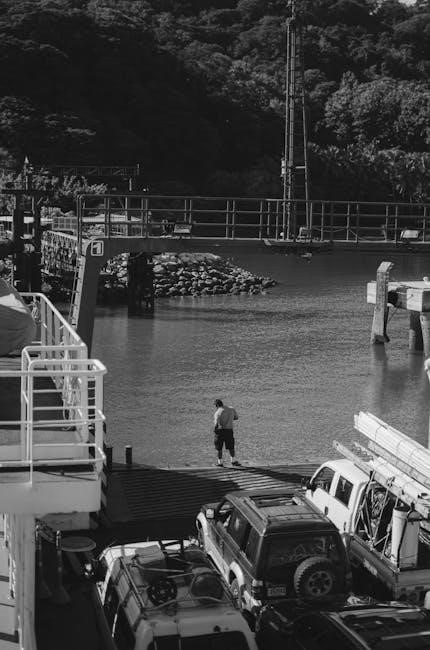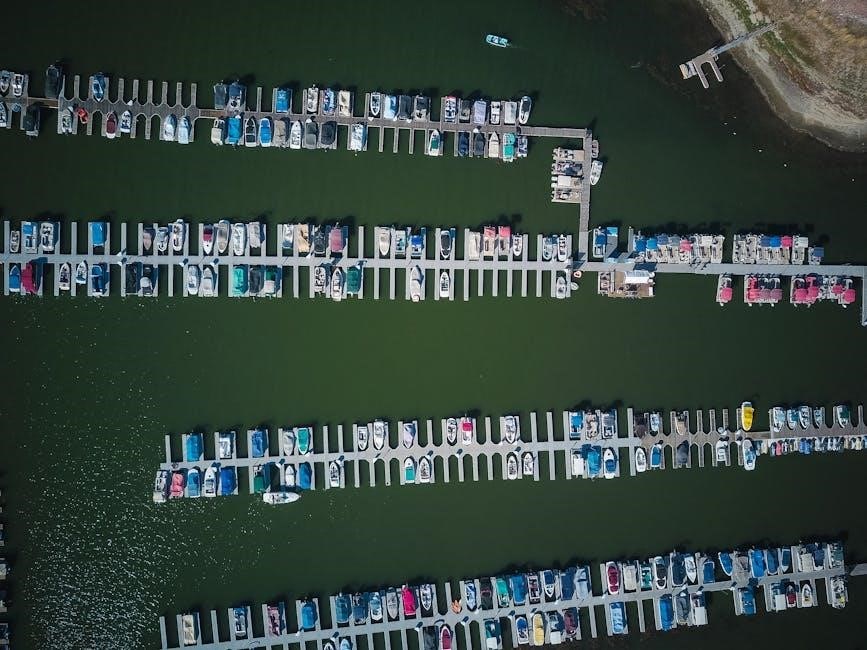Pontoon loading guides are essential, durable aids for safe and efficient boat handling. They provide alignment and support, ensuring secure transport and minimizing risks during loading and unloading.

Understanding the Importance of Pontoon Loading Guides
Pontoon loading guides enhance safety, efficiency, and ease during boat handling. They ensure proper alignment, prevent damage, and simplify the loading/unloading process, benefiting both experienced and novice boat users significantly.

Why Pontoon Loading Guides Are Essential for Safe and Efficient Loading

Pontoon loading guides are indispensable for ensuring safe and efficient loading processes. They provide clear alignment assistance, minimizing the risk of accidents and damage to the boat or trailer. By offering a stable and guided path, these systems reduce the likelihood of misalignment, which can lead to costly repairs or safety hazards. Additionally, they enhance visibility, especially in low-light conditions, helping operators navigate the pontoon onto the trailer with precision. These guides also streamline the loading process, saving time and effort, particularly for those with less experience. Their durable construction ensures long-term reliability, making them a worthwhile investment for any pontoon owner. Ultimately, pontoon loading guides are a practical solution that promotes safety, efficiency, and peace of mind for boat handlers of all skill levels.
Key Components of Pontoon Loading Guides
Pontoon loading guides typically include durable frames, alignment systems, and weight distribution supports. They often feature adjustable components, LED lights, and protective coatings for enhanced durability and visibility.
Physical Structure and Design of Loading Guides
Pontoon loading guides are typically constructed from durable, weather-resistant materials such as heavy-duty steel or aluminum, ensuring longevity and strength. Their design often features a sturdy frame with adjustable components to accommodate various pontoon sizes and trailer configurations. Many guides include LED lighting for improved visibility during low-light conditions. The frames are usually coated with protective finishes, such as powder coating or galvanization, to resist corrosion. Some systems incorporate roller or guide rail mechanisms to assist in centering the pontoon during loading. These guides may also include quick-release mechanisms for easy removal when not in use. The physical structure is designed to provide stability and support, minimizing friction and ensuring smooth loading and unloading processes. Additionally, some advanced models feature floating designs to adapt to changing water levels. Overall, the design prioritizes durability, ease of use, and adaptability to different conditions.
Alignment Systems for Proper Pontoon Loading
Alignment systems are crucial for ensuring pontoon boats are loaded and unloaded correctly. These systems typically include guide rails, LED lights, or adjustable markers to help center the boat on the trailer. Many modern designs feature retractable or foldable components to prevent damage during operation. Some advanced systems incorporate sensors or cameras for real-time alignment feedback. Guide rails often have a smooth surface to reduce friction and prevent scratching the pontoon. Adjustable features allow customization to fit various boat sizes and trailer setups. Proper alignment ensures even weight distribution, reduces the risk of damage, and simplifies the loading process. Additionally, some systems include floating guides that adapt to changing water levels, providing consistent alignment regardless of conditions. These features collectively enhance safety, efficiency, and user confidence during loading and unloading operations.
Weight Distribution and Capacity Considerations
Weight distribution and capacity are critical factors when using pontoon loading guides. Proper distribution ensures the pontoon’s weight is evenly spread across the trailer, preventing structural damage and maintaining stability. Loading guides often feature reinforced structures to handle the maximum weight capacity safely. It’s essential to know the Gross Trailer Weight Rating (GTW) and not exceed it. Overloading can lead to compromised safety and potential failure of the loading system. Guides are designed to accommodate various pontoon sizes, but adherence to manufacturer specifications is vital. Improper weight distribution can cause uneven stress on the trailer and pontoon hull, leading to costly repairs. Always ensure the pontoon is balanced front-to-back and side-to-side for safe transport. Regular inspections of the loading guides and trailer are recommended to verify their condition and capacity. Proper weight management ensures a secure and efficient loading process, minimizing risks during transit.

Safety Precautions When Using Pontoon Loading Guides
Always conduct pre-loading inspections of guides and trailers. Ensure proper alignment and secure the pontoon firmly. Use safety straps and follow capacity limits to prevent damage or accidents during loading.
Pre-Loading Safety Checks and Preparations
Before loading your pontoon, conduct a thorough inspection of the loading guides and trailer. Ensure all components are securely attached and free from damage or wear. Check the alignment system for proper functionality to guide the pontoon accurately onto the trailer. Verify that the weight distribution system is balanced and within the recommended capacity to prevent instability. Secure the pontoon with straps or tie-downs to prevent shifting during loading. Always wear safety gear, such as gloves, to protect yourself during the process. Ensure the ramp or launch area is clear of obstacles and debris. Test the trailer’s brakes and lights to confirm they are functioning correctly. Consult the owner’s manual for specific guidelines tailored to your pontoon and trailer setup. Proper preparation ensures a smooth and incident-free loading experience.
Safety During the Loading Process
During the loading process, maintain constant vigilance to ensure safety. Always stay alert and keep bystanders at a safe distance; Use visual aids like flag markers or reflective gear to enhance visibility. Operate the pontoon at a slow, controlled speed to avoid sudden movements. Ensure the trailer and ramp are stable and free from obstacles. Never overload the pontoon beyond its recommended capacity, as this can lead to instability. Use the loading guides to align the pontoon properly with the trailer, minimizing the risk of misalignment. Monitor the weight distribution to prevent tipping. Communicate clearly with anyone assisting, such as a spotter, to ensure smooth coordination. Avoid distractions, such as using a phone, while loading. Keep emergency equipment, like a fire extinguisher, nearby. Pause if conditions become unsafe, such as strong winds or low visibility, and reassess the situation.
Post-Loading Safety Inspections and Securing the Pontoon
After loading, conduct a thorough safety inspection to ensure everything is secure. Check all fasteners, straps, and chains to confirm they are tightly secured and properly positioned. Inspect the pontoon for any signs of damage or shifting during the loading process. Verify that the weight is evenly distributed and that the pontoon is centered on the trailer. Use the loading guides to double-check alignment and ensure the pontoon is stable. Once satisfied, secure the pontoon with high-quality straps or chains, tightening them firmly to prevent movement during transport. Consider using padded straps to protect the pontoon’s surface. Finally, walk around the entire setup to ensure no loose items are present and that all tie-down points are correctly engaged. This step is crucial for safe transportation and preventing potential hazards on the road.

Best Practices for Using Pontoon Loading Guides
Always follow manufacturer guidelines and conduct regular inspections of loading guides. Ensure proper alignment during loading and unloading to prevent damage. Secure the pontoon tightly and check fasteners regularly for optimal safety and efficiency.

Choosing the Right Loading Guides for Your Pontoon
Selecting the appropriate loading guides for your pontoon is crucial for safe and efficient operations. Begin by assessing your pontoon’s size, weight capacity, and trailer dimensions to ensure compatibility. Consider durable materials, such as heavy-duty steel, to withstand frequent use. Adjustable guides are ideal, as they allow customization to fit your specific pontoon. Additionally, look for systems with alignment features, such as guide rails or rollers, to simplify the loading process. It’s also important to evaluate the ease of installation and maintenance. Some guides come pre-assembled, while others may require customization. Consult with manufacturers or marine experts to identify the best option for your needs. Finally, ensure the guides are rated for your pontoon’s maximum weight and adhere to safety standards. The right loading guides will enhance your boating experience and protect your investment.

Maintenance and Care of Loading Guides
Proper maintenance and care of pontoon loading guides are essential to ensure their longevity and effectiveness. Regularly inspect the guides for signs of wear, such as rust, dents, or misalignment, and address these issues promptly. Clean the guides after each use to remove dirt, debris, or water residue, which can cause corrosion. Apply a rust-inhibiting coating or lubricant to moving parts to maintain smooth operation. Check and tighten any loose bolts or fasteners to prevent structural instability. Additionally, ensure the guides are stored in a dry, protected area when not in use to avoid environmental damage. Periodically test the alignment and adjust as needed to maintain proper loading accuracy. By following these maintenance steps, you can extend the lifespan of your loading guides and ensure safe, efficient pontoon operations. Regular upkeep is key to maintaining their reliability and performance.
Troubleshooting Common Issues with Pontoon Loading Guides
Common issues with pontoon loading guides often arise from misalignment, damage, or improper use. If the guides are misaligned, adjust them carefully to ensure proper fit and prevent damage to the pontoon or trailer. Inspect for signs of wear, such as bent or rusted components, and replace them if necessary. If the guides become obstructed by debris, clean them thoroughly to maintain smooth operation; Lubricate moving parts regularly to prevent corrosion and ensure effortless alignment; For persistent issues, consult the manufacturer’s instructions or seek professional assistance. Addressing these problems promptly can prevent further complications and ensure safe, efficient loading. Regular maintenance and inspections are key to resolving issues before they escalate. By staying proactive, you can extend the lifespan of your loading guides and maintain optimal performance.
